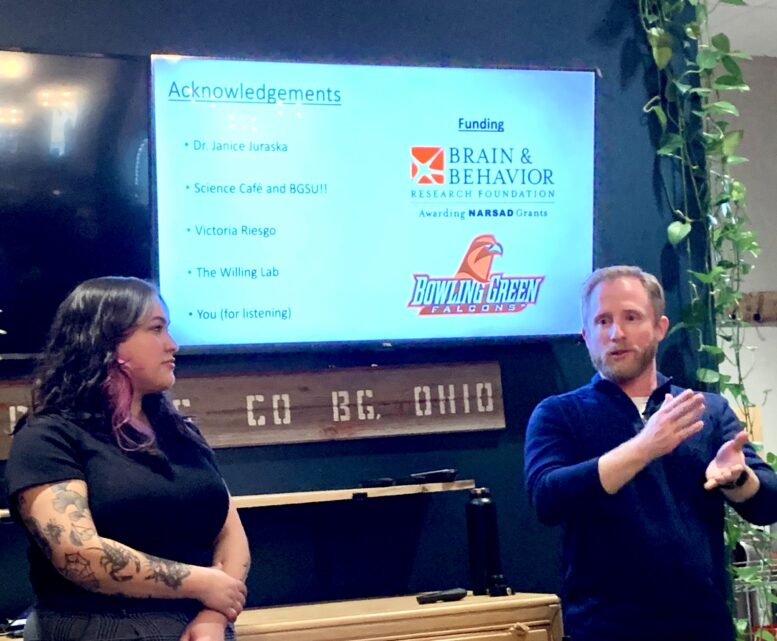By JULIE CARLE
BG Independent News
Adolescence is known as a time of dramatic changes in behavior. Teenagers may be more likely to engage in reward-seeking behaviors and take risks to earn that reward.
They are more vulnerable to try drugs of abuse and more susceptible to the effects of stress.
“Have you ever wondered why teenagers make what we think as relatively mild events into end-of-the-world situations?” Dr. Jari Willing, an assistant professor of neural and cognitive sciences at Bowling Green State University, asked during the April BGSU Science Café event.
“They are not just being dramatic, but adolescents are more susceptible to the effects of stress,” he explained, and the key seems to be the onset of puberty.
“On the plus side, we do see some amazing changes in cognitive behavior, learning memory and higher-order executive functions. We have a really good grasp over the major dramatic changes that take place in the adolescent period,” he said.
As one of the BGSU scientists looking into puberty and the brain, Willing’s work in the Department of Psychology and J.P. Scott Center for Neuroscience is making important inroads in the research. Because he is limited to working with rats rather than humans, he pointed out that rats have a prefrontal cortex in their brains that is surprisingly similar to humans.
One of the long-standing difficulties in adolescent neuroscience research is that the scientific community hasn’t agreed on when the transition between childhood and adulthood starts and ends. Instead of accounting for individual differences of maturation in adolescents, the traditional method is to pick “an almost arbitrary chronological age” which often ends up with “a lot of variability with results that don’t replicate across studies,” Willing said.
He is one of a small group of scientists diving into the adolescent period “to figure out what is explaining all the chaos,” he said. “Puberty is the main defining biological feature of the adolescent period, and almost always, puberty has been ignored in a lot of adolescent research in humans and rats.”
Luckily, pubertal development can be tracked. In humans, Tanner Stages 1-5 describe developmental changes for males and females that take place across multiple years. Rats go from pre-pubertal to post-pubertal in one day, Willing said. In both rats and humans, females reach puberty earlier than males.
Willing’s research has shown “pubertal onset is a major, if not THE major catalyst for brain development during adolescence.”
Most of the brain research on adolescent development has focused on the prefrontal cortex, thought to be among the last places of the brain to mature. The section of the brain that sits at the front of the brain has many roles; however, the primary role is to help in higher-order executive functions such as impulse control, judgment and the ability to change behaviors in changing environments.
“The prefrontal cortex continues to develop into your early 20s, which is the scientific rationale for keeping the drinking age at 21,” Willing said.
As those executive functions improve, the prefrontal cortex and the neurons and synapses in those regions shrink, it actually gets smaller (in size) in both humans and rats, he said.
A 2006 study—one of the first done in humans—identified a difference in adolescent prefrontal cortex development between females and males. The volume of the prefrontal cortex peaked in females about two years ahead of males. The difference is attributed to puberty.
“This is some of the first evidence that suggests that puberty may be a driving factor in development of this region,” Willing said.
When Willing’s team looked at the number of neurons in the prefrontal cortex in rats across adolescence, the rats in puberty at about 35 days old exhibited a drop in neuron numbers.
In another study, they prevented a surge in pubertal hormones in female rats by removing the ovaries. The rats did not have the drop in neurons, which “would suggest that pubertal onset or the pubertal hormones might what is driving the reduction of neurons in adolescence,” Willing said.
Further research looked at perineuronal nets (PNNs) which are protective shields in the brain that surround neurons. The protection of the PNNs prevents neuroplasticity and changes in the brain. Once the PNN numbers go through the short-term drop during puberty, cells are more vulnerable and likely to change and mature, he explained.
Animals that had reached puberty had a significant drop in PNNs. “What this is suggesting is that pubertal onset open up this period of plasticity and maturation within the window of adolescence,” Willing said.
Looking at whether the neuroanatomical changes result in changes in behavior is a topic they are “most interested in,” he said.
They developed a behavioral study to test any differences in spatial learning and adaptability of rats at different stages of adolescence. The study found animals that were past puberty completed the task in less time than the animals who were not yet in puberty. The pre-pubertal rats not only were slower, but they “almost showed signs of stubbornness,” he said, referencing the typical changes of behavior during adolescence.
They discovered that dopamine is one of the connections that plays a role in puberty.
Doctoral student Victoria “Tori” Riesgo’s is studying what puberty does to the ventral tegmental area (VTA), a section toward the back of the brain that produces dopamine, which is then received by the prefrontal cortex.
Thus far, the research suggests, that similar to the prefrontal cortex, the ventral tegmental area is sensitive to puberty hormones as evidenced by a period of growth relative to puberty, Willing said.
Riesgo is one of the first to show that the PNNs are present in the ventral tegmental area, “making the region just as susceptible to puberty as the prefrontal cortex,” he said. The research “could change the game of how we think of adolescence.”
The finding is important because identifying a small window of time when brain changes are happening more rapidly opens up a greater susceptibility and vulnerability to external influences such as environmental toxicants and stress.
“The smaller window of pubertal onset might confer that there is some extra vulnerability to things like stress,” he said.” Pre-pubertal stress, but not post-pubertal stress, altered the brain’s neural anatomy and also altered pre-pulse inhibition,” which Willing defined as a softer sound before a loud, startling sound that diminishes the response to the louder sound.
Individuals diagnosed with schizophrenia have less of a diminished response from the pre-pulse inhibition. “The smaller window when changes are taking place more rapidly offers insight into when people might be more vulnerable to influences that can more likely create mental illness,” he said.
Conversely, the small timeframe when vast changes are taking place could also offer a window of opportunity to provide positivity and enrichment to correct or change some of the experiences or traumas of earlier life, he said.
When asked if their work informs parents of children going through adolescence, Willing said, “From the data thus far, it may suggest that we need more enriching activities, specifically at the onset of puberty that can benefit your child. R educe stress to the best of your ability, engage in positive activities, and promote resilience and a positive mindset to protect against stress.”





